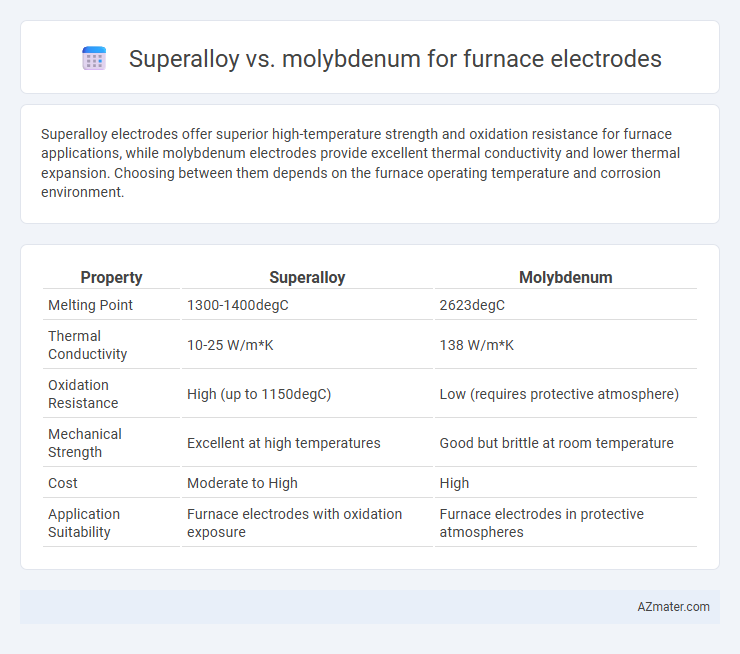Superalloy electrodes offer superior high-temperature strength and oxidation resistance for furnace applications, while molybdenum electrodes provide excellent thermal conductivity and lower thermal expansion. Choosing between them depends on the furnace operating temperature and corrosion environment.
Table of Comparison
| Property | Superalloy | Molybdenum |
|---|---|---|
| Melting Point | 1300-1400degC | 2623degC |
| Thermal Conductivity | 10-25 W/m*K | 138 W/m*K |
| Oxidation Resistance | High (up to 1150degC) | Low (requires protective atmosphere) |
| Mechanical Strength | Excellent at high temperatures | Good but brittle at room temperature |
| Cost | Moderate to High | High |
| Application Suitability | Furnace electrodes with oxidation exposure | Furnace electrodes in protective atmospheres |
Introduction to Furnace Electrode Materials
Superalloys and molybdenum are critical materials for furnace electrodes due to their exceptional high-temperature stability and electrical conductivity. Superalloys, composed of nickel, cobalt, and iron bases with added elements like chromium and aluminum, offer excellent oxidation resistance and mechanical strength under extreme thermal cycles. Molybdenum provides superior thermal conductivity and resistance to thermal expansion, making it ideal for maintaining electrode integrity in ultra-high-temperature furnace environments.
Overview of Superalloys in Furnace Applications
Superalloys used in furnace electrodes exhibit exceptional high-temperature strength, corrosion resistance, and oxidation resistance, making them ideal for demanding industrial furnace environments. These materials, often based on nickel, cobalt, or iron, maintain mechanical integrity and electrical conductivity under extreme thermal cycling and harsh chemical exposures. Their superior performance outshines molybdenum electrodes in prolonging lifespan and reducing maintenance in high-temperature furnace applications.
Properties of Molybdenum as an Electrode Material
Molybdenum exhibits exceptional high-temperature strength and excellent thermal stability, making it ideal for furnace electrode applications under extreme conditions. Its low thermal expansion and high melting point (2623degC) ensure minimal deformation and extended lifespan during continuous operation. Superior electrical conductivity combined with strong corrosion resistance enhances efficiency and durability in harsh furnace environments.
High-Temperature Performance: Superalloy vs Molybdenum
Superalloys exhibit superior high-temperature performance compared to molybdenum in furnace electrodes due to their enhanced oxidation resistance and structural stability at temperatures exceeding 1000degC. Molybdenum, while offering excellent thermal conductivity and resistance to thermal shock, tends to oxidize rapidly above 600degC, reducing its lifespan in oxidizing environments. The choice of superalloy electrodes ensures longer service life and consistent electrical performance in high-temperature furnace applications.
Electrical Conductivity Comparison
Superalloys typically exhibit lower electrical conductivity compared to molybdenum, making molybdenum a preferred choice for furnace electrodes where efficient current flow is critical. Molybdenum offers conductivity values around 18 million siemens per meter (MS/m), whereas superalloys range significantly lower due to alloying elements that disrupt electron mobility. This higher conductivity of molybdenum enhances electrode performance by minimizing resistance and heat generation during high-temperature furnace operations.
Resistance to Oxidation and Corrosion
Superalloys demonstrate superior resistance to oxidation and corrosion compared to molybdenum when used as furnace electrodes, due to their high chromium and nickel content forming protective oxide layers. Molybdenum, while having excellent high-temperature strength, tends to oxidize rapidly in furnace environments lacking protective atmospheres, leading to premature degradation. The enhanced oxide scale stability of superalloys significantly extends electrode lifespan in aggressive furnace conditions prone to oxidation and corrosive gases.
Mechanical Strength and Durability
Superalloys exhibit superior mechanical strength and high-temperature durability compared to molybdenum, making them ideal for furnace electrode applications requiring resistance to thermal fatigue and mechanical stress. Molybdenum, while offering excellent thermal conductivity and resistance to creep at elevated temperatures, typically has lower tensile strength and toughness under cyclic loading conditions. The enhanced grain structure and alloying elements in superalloys contribute to their prolonged lifespan and consistent performance in harsh furnace environments.
Cost Analysis and Lifespan
Superalloy electrodes typically exhibit higher initial costs compared to molybdenum due to their complex alloy composition and enhanced oxidation resistance. Molybdenum electrodes, while more affordable upfront, often have shorter operational lifespans under high-temperature furnace conditions because of their susceptibility to oxidation and thermal degradation. Cost analysis favors molybdenum for low-budget applications, but the extended lifespan and reduced maintenance frequency of superalloy electrodes can result in lower total cost of ownership in demanding industrial furnaces.
Suitability for Different Furnace Types
Superalloys exhibit superior performance in electric arc and induction furnaces due to their excellent resistance to oxidation, thermal fatigue, and molten metal corrosion. Molybdenum electrodes are better suited for vacuum and high-temperature refining furnaces because of their high melting point, excellent thermal conductivity, and low reactivity with molten metals. Selecting between superalloy and molybdenum electrodes depends on furnace type, operating temperature, and atmosphere, with superalloys preferred for oxidizing conditions and molybdenum favored in inert or vacuum environments.
Conclusion: Choosing the Right Electrode Material
Selecting the right electrode material for furnace applications depends on the specific thermal and mechanical requirements. Superalloys offer superior oxidation resistance and high-temperature strength, making them ideal for harsh, high-temperature environments. Molybdenum provides excellent thermal conductivity and cost efficiency but may require protective atmospheres to prevent oxidation.

Infographic: Superalloy vs Molybdenum for Furnace Electrode
 azmater.com
azmater.com